A Paipo Interview with Craig Matthew
August 13, 2012 - Utah (USA)
E-mail interview by Bob Green
Craig Matthew spent many years lifeguarding, surfing and competing at Makapu`u,
as well as riding paipo boards around Oahu. He describes the the
paipo contests of the 1970s and 1980s, and surfers who rode in those
contests. A mentor of Craig's was Harry Akisada, who also made his
current board. These streamlined boards are known for their speed and
maneuverability.
|
1. When
and where did you get into bodysurfing?
I grew up bodysurfing Kailua Shorebreak, from when I was a 12-years-old, never
getting interested in stand-up board surfing. Makapu`u was my second
home by the time I was 15. In fact, I was such a water-rat there that
at 17, before I'd even finished high school, one of the lifeguards
there convinced me to apply for a part-time, weekend position that was
available. I started guarding there in May of 1968, and continued until
November of 1974, when I joined the Honolulu Fire Department.
Sometime in high school, probably around 1966-1967, I was given a Val
Valentine Paipo Nui that I used some, mostly at Makapu`u, but also
at Velzyland and Ehukai once in a while. That started me paipo riding.
It wasn't until I was lifeguarding that I really got into
paipo boarding, through two friends, George Paku (Paku passed away
around 1980) and Harry Akisada, who is still riding paipo boards. I
have continued to paipo, just not as much.
|
|
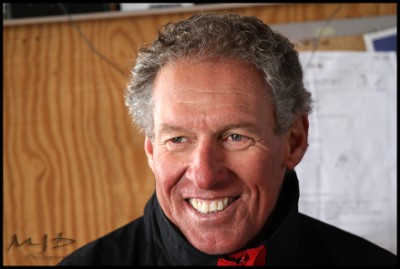
Craig Matthew, ca. 2012.
Photo courtesy of Craig Matthew.
|
2. What was the attraction of the wave at Makapu`u?
Makapu`u has several spots that depending upon the angle and size of
the swells form several peaks that provide long, breaking waves.
The opportunity to get bigger, longer rides always made the place
attractive. Paipo boarding allowed me to catch even bigger waves than I
could bodysurfing. Also, Makapu`u gets surf throughout the entire year.
The trade winds produce swells off-and-on over close to 8 to 10 months,
the beach faces northeast, and gets the "wrap" from large, winter
swells, as well as east or southeast, summer swells. (See Note 1
for more information on Makapu`u.)
3. How did you become lifeguard and for how long?
In 1968, the Vietnam War was beginning to escalate and Hawaii's 29th
Brigade of the Army National Guard was called to active duty. Several
of the City and County Lifeguards were among those called. One of the
lifeguards, Bernie Ho, had known me for several years and I had often
helped the lifeguards with rescuing swimmers caught in currents
generated by the surf, knew that I was about to finish high school and
asked me if I wanted a job lifeguarding. Bernie told me where to go to
apply. I applied on a Monday and the Captain of the lifeguards asked me to
start at Makapu`u that Saturday and Sunday. That was May 18, 1968. I
worked as a lifeguard until the Honolulu Fire Department hired me on
November 18, 1974, so I lifeguarded for six and a half years. I was able to complete my
education at the University of Hawaii during that period as well.
4. What was the most dangerous rescue that you had to do?
Luckily, the majority of the rescues at Makapu`u were what we usually
called "playing tour guide." A big set of waves would come in and sweep
a bunch of swimmers/bodysurfers out of the shorebreak area into one
section of the bay or another and one of us would go "herd" them back
into the shore. North swells would produce a big shorebreak similar to
Waimea Bay's and a very strong current would push out along the rocky
cliffs that form the eastern end of the bay. Trade wind swells would
generate currents along the rocky western shore of the bay.
Frequently, we would have to save scared, tired swimmers who, after
struggling with either current, would decide to quit fighting and swim
in over the rocks, in the surf. Getting to those swimmers and saving
them from getting slammed by the surf into those rocks was probably the
most dangerous part of the job.
Occasionally, getting through the shore break's "washing machine" was
pretty exciting too. The entire Makapu`u beach, while sandy during the
calmer, summer months, is actually lava rock covered by the sand. The
winter surf will shift the sand and expose the rocky bottom, making the
currents stronger in areas and the shorebreak more treacherous in those
spots as well.
Makapu`u shorebreak.
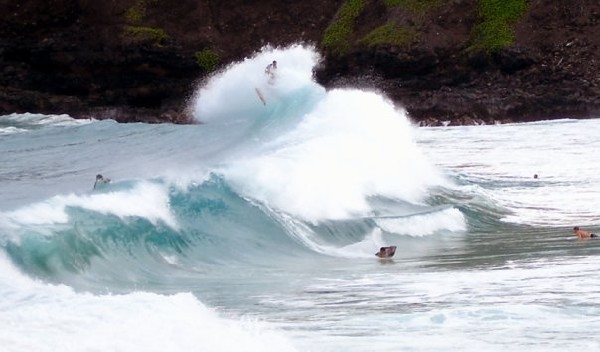
Photo courtesy of Bud Sclesa.
5. What style of board did you ride?
My first paipo was a Paipo Nui made by Val Valentine. It was made of
3/8" plywood and teardrop shaped with a slightly, upturned nose. It
was about 40 inches long. It was fun in small surf. My next board was 3/4"
plywood, flat and bullet-shaped and fibreglass covered. George Paku had
made it in a high school wood shop class. I briefly used it before a
beach regular, Harry Akisada, offered me one of his "old" boards. I
used it for a couple of years, before Harry made my current board for
me in 1974.
Harry laminates his own plywood using 3 layers of 1/8" veneer.
He shapes the boards by pressing the wood in a mould that he designed
and built. During the gluing process the 3 layers are pressed in his
mould and afterwards he does some finish shaping (mostly sanding). He
then fibreglasses the boards for added strength and a smoother finish.
The finished boards look like something from a pro surf shop. His
classic shape is almost bullet shaped, average around 42 to 46 inches long and
about 30 inches wide. They have a slight spoon to the front portion and both
side-edges have a slight concave turn along the long axis. This helps
the board hold into and climb or drop on the face of waves as they get
steeper.
Left:
Francis "Frank"
Lee and Craig Matthew (on right), ca. 1973. Frank is holding a board he
built and Craig Matthew is holding his first board from Harry. Photo
on the right: Frank Lee contest surfing.
|
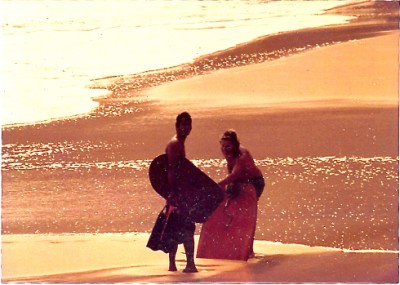
|
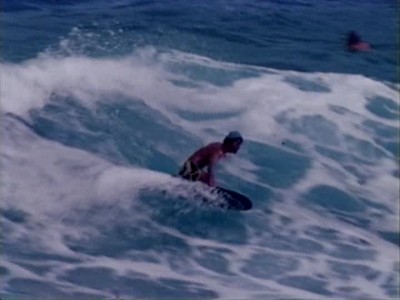
|
Frank
was mostly a knee
rider but after several years he shifted to riding prone on big,
or bumpy days. Regarding the photograph on the left, Craig noted, "I
know from the color of the board that it was taken around 1973. The
photo was at Makapu`u and I think we had just finished our paipo heat at
the contest because It looks like the string of my "colored beanie" on
top of the board. Originally we used water polo hats/beanies to
distinguish competitors in their heats and after a couple of years we
had hats made in brighter colors."
|
Left: Photo by Karen Lee. Right: Photo by Wayne Bartlett, courtesy of Stan Osserman.
6. What influence has Harry Akisada had on your surfing?
It's hard to describe just how big an impact Harry has been to me. His
boards really got me going on paipo riding. Before that a paipo was
more for playing around. Friendship also came with the boards along with the
chance to learn and refine technique. We had a small group of paipo
riders that would also travel to various spots around the island to
surf, which broadened my horizons, surfing various types of breaks,
conditions and sizes of surf.
Left: Bud Scelsa, Harry and Noah Cashman at Makapu'u, ca. 1974. Right:
Harry on the day of Ray Ho'okano's funeral, ca. 2008.
|
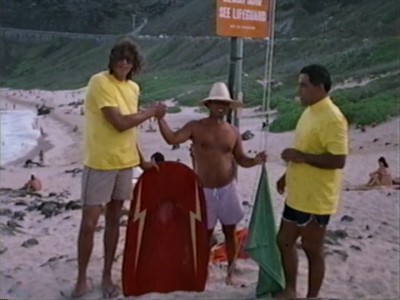
Larry Goddard spoke to Harry about
the photo: "The board was
specially made to be a 1st Place prize for
the 1974 Paipo Championships
at Makapu'u. But...Ha! That was the year
that Harry won the contest! So
he told the contest organizers to award
it to the 2nd-Place winner."
Photos by Wayne Bartlett and Larry Goddard.
|
|
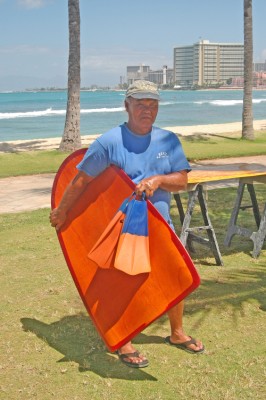
|
Harry surfing in a paipo contest, ca. 1970s.
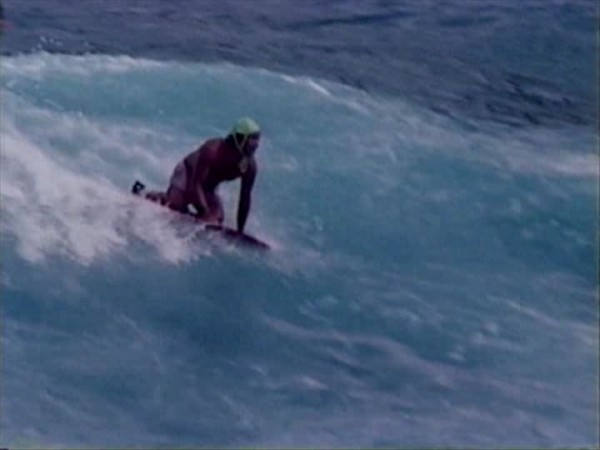
Photo by Wayne Bartlett,
courtesy Stan Osserman.
7. Harry Akisada's name repeatedly comes up when paipo riders
are mentioned and I've heard that even at the age of 60, or so, that
Harry puts in some very long sessions. Can you say a bit about his
boards and his surfing?
Harry will routinely put in 4 to 6 hour sessions. He has never been
one to go out for an hour or two, and then go in to rest on shore,
preferring one continuous session for as long as the waves hold out.
For prone riding his boards are simply the best. People have tried to
copy them - unsuccessfully - but they are fast, hold into the steepest
sections and yet easy to manoeuvre, or to cut back and easy to pearl
when a quick exit is necessary. They are slightly positively buoyant,
so they're easy to find after a wipeout, but also easy to take
underwater and get out through the surf.
Looking at Stan
Osserman's board (see below), you can see
where he has been influenced by Harry's designs, e.g., the slight scoop
of
the nose which everybody has picked up on. But the downturned edges to
form
a slightly "channeled bottom" and a slightly raised "tunnel" to the
aft, half to two-thirds of the board, forming a channel along the
bottom, are features that are Harry's refinements.
Stan Osserman's paipo board was influenced by Harry's Akisada's designs.
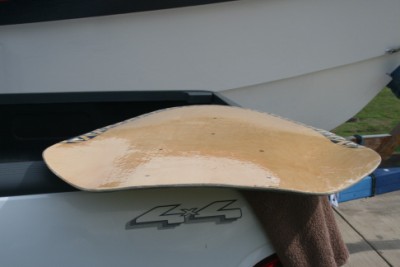 |
|
Backing up
historically, starting in the early- to mid-1960s, Harry used to paipo
with an older man, Glenn, but we used to call him "Batman." The
"Batman" name was coined because of the board that he rode. It was big, maybe
48 inches long and probably 36 to 40 inches wide. But the board was shaped much like
Stan Osserman's except the sides were almost like wings with an even
more pronounced, downturned shape.
I know that Harry's designs pretty much evolved from the Batman's
board, but have not been as radical (see Note 2). My board's side, edge-channels aren't as big or deep, but the
center-channel is a little more defined. I know that Harry's theory is
that the edges will help hold into the wave's wall, especially as it
gets steeper, and that as the center-channel gets air into it, the
board will begin to hydroplane giving it more speed. I feel that it
works. My first board made by Harry Akisada was basically flat but had the shaped
edges. It was fast and held the wall pretty well. My current board has
the center channel as well as the edge shape and it IS faster and more
responsive in turning, while still holding onto the walls.
|
Caption by Craig Matthew and
photo courtesy of Stan Osserman.
"Big Ed" Earmore with his new triple-concave that was inspired by Harry Akisada's
design.
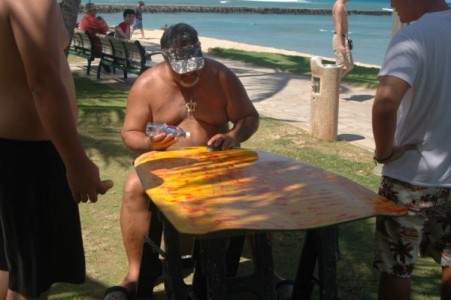
Photo by Larry Goddard.
8. Where did you mostly go paipo surfing? What types of waves
were paipo boards best suited for?
Most of my riding has been at Makapu`u simply because its my backyard.
It's home. But through Harry, we surfed a lot of other areas, following
the seasonal cycles… North Shore some during the winters
(everywhere from Velzyland, Sunset, Pupukea, Laniakea, Haleiwa (a few
times) and Mokuleiea). As the North Shore got more crowded, we would head
towards the Leeward-side… Tracks (some), Maili Point and Makaha
(usually when Makaha Larry called with word that it was good).
Summertime we would head to Town… Publics, First Break, the Wall
in Waikiki (Kapahulu Groin), Magic Island, Baby Haleiwa, sometimes
Portlock Point if it was breaking on the outside reef with a good wrap,
and even outside at Sandy Beach, especially when it was getting the
Northerly or Easterly wrap.
Craig Matthew paipo
surfing.
|
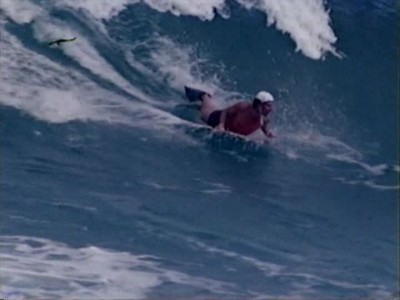
|
|
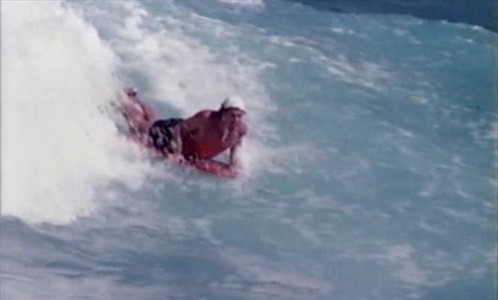
|
Photos by Wayne Bartlett, courtesy of Stan Osserman.
Harry's boards can handle any and all conditions or types of surf. The
edge-shape allows it to hold onto the wall of a steep section without
sideslipping, but it's easy to cutback, climb the wave face, or drop
around a white water section. You have speed when you want it, but you
can stall and let sections form or re-form when you want that as well. Two
examples of the board's versatility - it holds into and will allow you
to make tubing sections at Pipeline or Point Panic, but it also has the
speed and glide to catch a wave at outside First Break, ride the
breaking wave, and then the swell as the wave moves into Public's and
reforms, but then you can continue on the swell all the way to the Wall,
and the sand.
9. What crossover do you see between bodysurfing and
paipo surfing technique?
Bodysurfing, it was always just the wave and me. But I would be limited
- in what waves I could catch - the breaking wave might force me to cut
out where a board could get through or around a section. The paipo
gives me a lot more freedom, but still the feeling, the excitement of
being close to the wave.
10. I've read you surfed and won a few paipo contests.
What can you tell me about these contests?
When I was lifeguarding at Makapu`u, Chuck Shipman approached
several of the regulars at Makapu`u with the concept of (1) a contest
there, (2) starting a series of contests around the island, Makapu`u,
Sandy Beach, North Shore and somewhere in Town (finally settling on
Ehukai Beach Park area and Point Panic). Chuck worked for the City's
Department of Parks and Recreation and his job was to try to develop
more recreational opportunities in the community. His idea was to get
the
"regulars" at each area involved and to organize clubs that would
produce their respective area's contest.
Makapu`u was the first. Chuck helped us to organize it and nurse it
along. The core group consisted of bodysurfers and paipo riders from
all walks of life, but all with Makapu`u as the common thread There
were several regulars who played very active roles in bringing the
Makapu`u contest together in the begining - myself, Roger Takabayashi,
Jake Hekekia, Herbert Horita (a bodysurfer and real estate developer
who sponsored us the first few years), Ed Stroup, Stan Osserman, Wayne
Bartlett, Larry MacArthur, John Naughton, Black Lum-King, Blah Pahinui,
Ed Schell, Bill Saunders and a lot of others who were willing to
provide manpower over the years. As a club, we ran the Makapu`u Contest
for more than 10 years, before turning it over to some other - new
regulars, if you will - who continued a few more years. We're talking
approximately 1970 up to about 1985. By the mid-1980's, the contest, in
all of them, were suffering from declining interest and participation.
T-shirts for
the third (1973) and fifth (1974) Makapu`u
contests. The 1973 t-shirt design is by Jerry Vasconcellos and the 1974 design is by Stan Osserman.
|
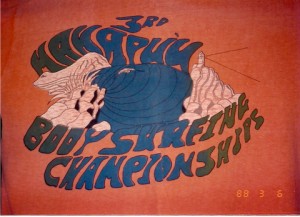
|
|

|
Photos courtesy of Craig Matthew.
|
T-shirts for
the sixth (1975) and seventh (1976) Makapu`u contests
|
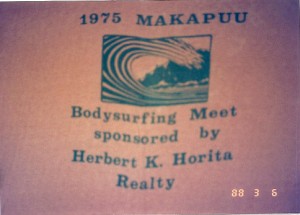
|
|
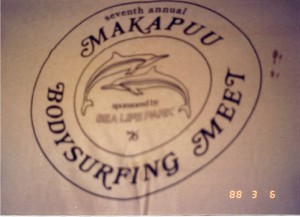
|
Photos courtesy of Craig Matthew.
|
T-shirts for
the 1980 (Stan Osserman design) and 1981 Makapu`u contests.
|
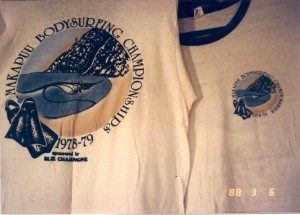
|
|
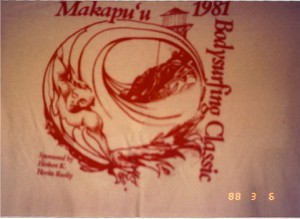
|
Note:
In 1979-1980, there was only one contest. 1979 was missed completely.
That period was the transition between one group and another in running
the contest. Roger Takabayashi and I both had too many other things
going in our lives, and some others were willing to take over the
contest, butit took a while for them to get organized.
|
Photos courtesy of Craig Matthew.
The contests were fun. For me, they came at a time when the competitive
juices were flowing (my 20s and 30s). At Makapu`u, the purpose of the
contest was to raise money to have a big party for the "Club members."
Basically, a couple of parties at the beach where all the regular,
frequent beach-people could have a good time, eat some, drink some,
and socialize. A lot of good friendships came out of the contests and
the subsequent partying. The contest circuit also brought people who
were regulars at other beaches to our spot and vice-versa for the
competition and the partying. This made for extended friendships and
made it easier to go other beaches and have friends there. There was
some recognition and prestige too, which was nice, but there was some
role-modelling, also. It was fun to see young kids perform, develop and
go on to their own fame in surfing. In the beginning, the Sandy Beach
contest had John Clark, Riley Smith, Herbie Knudsen among others.
Robert Thomas ran the Point Panic contest.
Of the contest Criag
wrote, 'In the early years of the North Shore contests, the City didn't
have lifeguards at many of the North Shore beaches. Only Sunset, Waimea
and Haleiwa had guards. The contest promoters would request the City's
cooperation in providing a lifeguard for the contest dates. I would
always volunteer to take the assignment. I'd "work" the contest days
and also compete in my events. Then, I took first place and the
newspaper notice was printed, my Captain saw it, congratulated me but
also told me that I wouldn't get paid for those days. Oh well."
Trophy for the
1981 Makapu`u contest and 1974 contest results.
|
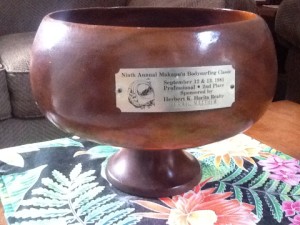
|
|
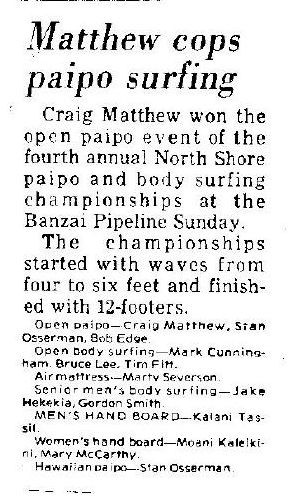
|
Photos courtesy of Craig Matthew and Stan Osserman.
11. Did you mostly ride kneeling or prone?
I ride prone. I tried kneeling, but my knees would swell and hurt for a
day or two afterwards. Prone was more fun.
12. What was the attraction of riding a paipo and are
there some surfs that still stand out for you?
The paipo gives me a lot more freedom than bodysurfing but still has
the feeling and the excitement of being close to the wave.
There are sessions at every spot that stand out. Certainly some more
than others…
- A couple of center breaks out in the middle of Makapu`u's bay, 6 to 10 foot
with a rare, offshore breeze and LONG right walls.
- Thanksgiving Day, 1974. I had just joined the Fire Department, had
the day off and several of us, Stan Osserman, Frank Lee, Wayne
Bartlett, Harry Akisada and I, went to Makaha. It was coming up in the
morning and averaging around 10-foot but glassy. We surfed the point until
it got crowded and then moved to Maili Point where we spent the rest of
the day with the place to ourselves. Still glassy conditions and
incredibly long walls. It'd take more than 10 minutes to kick back out
after each wave. Harry came for dinner that evening and we both fell
asleep at the table which my wife had spent all day preparing. Oh, but
the surf was worth it!
-
A day at Pupukea in 3-6' surf with Harry and one other paipo rider.
We would take off at the peak on waves that were big mounds, but as the
waves came into the shorebreak they would go vertical and barrel. We
would be going into that barrel from the back door, get completely
tubed until we emerged in front of the Ehukai Beach Lifeguard Tower.
There was no cutting out, just pull up on the outside rail and hold on
until we'd get spit out. The paipos were the only ones who could make
the section, everyone else was getting buried.
-
There were occasional days in the Makapu`u shorebreak when the sand
would be out leaving a rock shelf exposed. We'd be able to get short
100+ yard barrels in 2 to 3 foot surf that were similar to the Pupukea to
Ehukai experience…just smaller surf and shorter rides but still
clean and fun.
13. Do you still ride a paipo board?
Yes. Not as much obviously, since I now live on the Mainland. I retired
from the Fire Department in 2003, moved to Park City, a ski town in
Utah and now ski all winter. I work as a Ski Patroller and manage to
put in my 100+ days on skis. But my wife and I return to Hawaii every
spring after the ski area closes and we spend a couple of months
thawing out, eating local food, and seeing friends and family. I get in the
water with my paipo board. Usually I'm lucky enough to catch the first
summer swells along the South Shore.
Craig in the Deer Valley Ski area, where he has been a
Ski Patroler for the last 9 seasons.
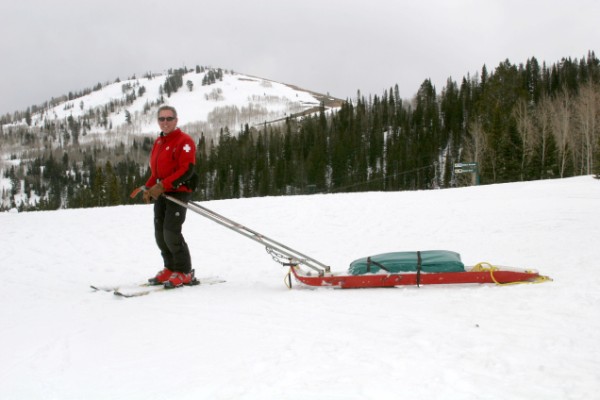
Caption and photo courtesy of
Craig Matthew.
14. One purpose of interviews like this one is to
contribute to preserving a history that is largely undocumented. Any
other names or stories that you would like to include?
A lot of names have already been listed, but a few come to mind: George
Paku, Clyde Dement, "Big Al" Kaalele, Toby Tobin, Ed "Dick" Stroup,
Mike "Mickey" Broderick, Alan Kertes, Bronson Achiu and George
"Shiseido Man" Grubb are some names that haven't been listed by others.
They all paipo'd Makapu`u at one time or another. This isn't to take
away from any of the other names that you already know, just to add to
the list.
Stories… they're hard to come by. It'd require a few drinks,
start with one and then things would flow. Maybe another time and
place. Maybe a project for my next return to Honolulu… hmmmm.
|
Note 1. The location, history and origin of the name Makapu`u.
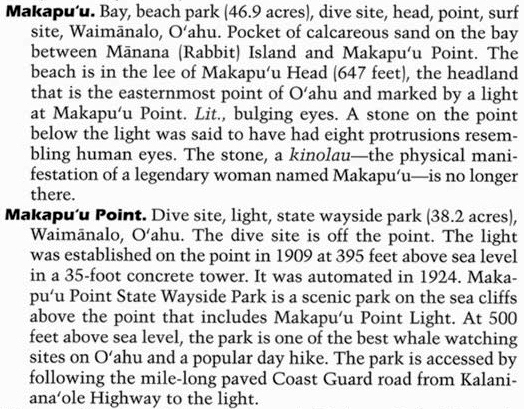
Source: Clark, John R. K. 2002. Hawaiʻi place names: shores, beaches, and surf sites. Honolulu: University of Hawaiʻi Press, p. 231.
Makapu`u outside peak, March 3, 2009.
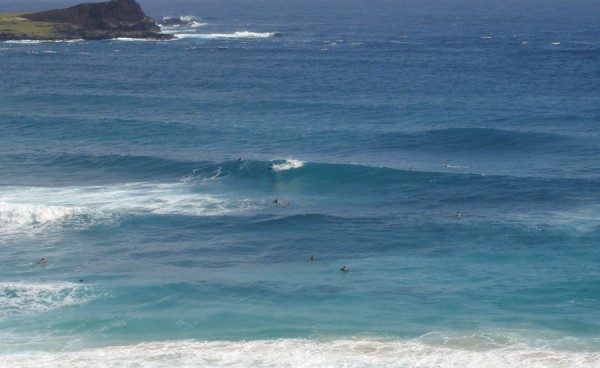
Photo by Bud Scelsa.
Note 2:
Information regarding Glenn and other paipo riders.
Larry Goddard provided the following
information via e-mail, August 18, 2012:
I
just had a long conversation today with Harry Akisada. He told me that
Alan
Glenn Bickham was one of his surfing buddies for 15 years.... Glenn
was a Haole guy from Pennsylvania, and was a wood-working expert,
employed at Schofield Barracks on Oahu in the late-1950s and into the
1960s. He was the one who taught Harry and his paipo-riding buddies how
to construct a well-made wooden paipo board. Harry learned even more
from his own experiments with mold design, used to achieve the
sophisticated compound curves that are a trademark of his
triple-concave boards. Glenn married a Japanese-American gal named
Grace ... and lived in Kaneohe (East side of Oahu, home of the Marine
Corps Base, Hawaii), and he and his friends went surfing at Makapu`u,
Sandy Beach, Publics, Sandbars, Cunhas, and Magic Island. He was about
10
years older than Harry.
Larry Goddard provided the following information via e-mail, August 21,
2012:
You said Craig mentioned a friend of Harry's, a paipo rider named
Kenneth Sakamoto (who rode one of Harry's paipo designs). YES! Kenny
was my surfing buddy in the mid- to late-1980s. We often drove to the North
Shore for winter surf (up to 10 to 12 feet). If it was bigger than that, we
just went to Makaha. Ken wasn't flashy in his surfing style, but he
LOVED to go fast, and few people could keep up with him. Ken died of
cancer in January, 1998... a couple weeks after Rell Sunn, the "Queen of
Makaha," died of cancer. Several weeks later, we had the huge January
28th, 1998, swell (50+ foot on the North Shore).
Other info: goes here.
|
|